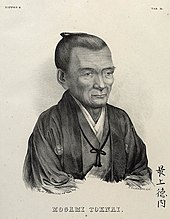Mogami Tokunai
Mogami Tokunai ( Japanese 最 上 徳 内 ; born 1754 in Dewa Province (now Murayama in Yamagata Prefecture ); died October 14, 1836 ) was a Japanese researcher who made a name for himself in the study of Hokkaidō , Sakhalin and the Kuril Islands .
life and work
Mogami Tokunai went to Edo in 1781 and studied land surveying and navigation under the mathematician Honda Toshiaki (1744-1821). In 1785 he went with an expedition to Ezo, today's Hokkaidō and the following year to Sakhalin, where he mapped the southern part, including the southern Kuril Islands. He was the first Japanese who has been proven to visit the Kuril Islands Etorofu and Uruppu . A meeting with a Russian on Etorufu led him to point out the island's importance for national security. During the next two decades, Mogami made several research trips through Sakhalin and the Kuril Islands. He was an astute observer of the Ainu and the Russians and learned both languages.
When Philipp Franz von Siebold came to Edo in 1826 when the Dutch were waiting for the Shogun, Mamiya visited him several times. Mamiya reported on his travels to the north and gave him a map of Sakhalin. He supported Siebold in his endeavors to create an Ainu dictionary.
The memorial museum "Mogami Tokunai Kinenkan" (最 上 徳 内 記念 Ged) was opened in 1993 at the birthplace of Murayama.
Remarks
literature
- S. Noma (Ed.): Mogami Tokunai . In: Japan. An Illustrated Encyclopedia. Kodansha, 1993, ISBN 4-06-205938-X , p. 996.
Web links
| personal data | |
|---|---|
| SURNAME | Mogami, Tokunai |
| ALTERNATIVE NAMES | 最 上 徳 内 (Japanese) |
| BRIEF DESCRIPTION | Japanese explorer and cartographer |
| DATE OF BIRTH | 1754 |
| PLACE OF BIRTH | Murayama |
| DATE OF DEATH | October 14, 1836 |

